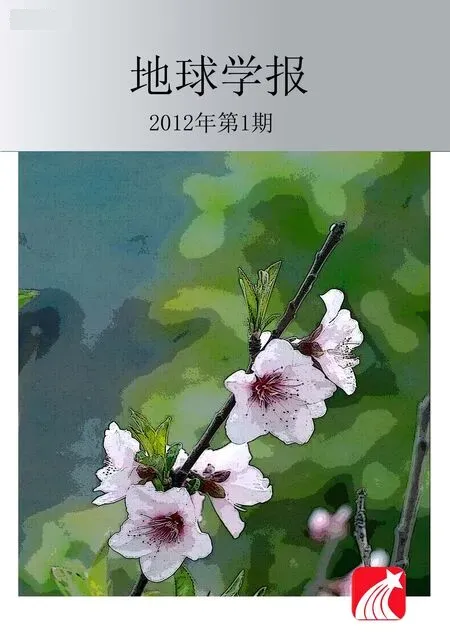西南日本黒濑川带的解剖:晚二叠世和早侏罗世增生混杂岩的构造-地层学与浅变质作用
2012-04-01HIDETOSHIHARA,KURIHARATOSHIYUKI,HIROSHIMORI
西南日本黒濑川带的解剖:晚二叠世和早侏罗世增生混杂岩的构造-地层学与浅变质作用
E-mail: hara-hide@aist.go.jp.
The Kurosegawa belt forms a relatively narrow terrane that can be traced continuously throughout southwest and central Japan. The major constituent continental fragments of the Kurosegawa belt include Early Paleozoic granitic rocks, high-grade metamorphic rocks, Carboniferous metamorphic rocks (epidote-amphibolite facies), Triassic-Early Jurassic metamorphic rocks (pumpellyite-actinolite facies),serpentinites of unknown age, Silurian–Devonian volcanoclastic rocks intercalated with limestones, and Permian–Jurassic shallow marine sediments (e.g.,Ichikawa et al., 1956; Maruyama et al., 1984; Faure,1985; Yoshikura et al., 1990; Aitchison et al., 1991,1996; Hada et al., 1992, 2001; Isozaki et al., 1992).These diverse rock suites are highly disrupted, forming lenticular bodies within the Late Permian accretionary complex (AC) which collectively are covered by younger (Cretaceous) marine to brackish water sediments (e.g., Aitchison et al., 1991; Isozaki et al.,1992). We characterize the tectono-stratigraphic architecture and low-grade metamorphism of the accretionary complex preserved in the Kurosegawa belt of the Kitagawa district in eastern Shikoku, Southwest Japan, in order to understand its internal structure,tectono-metamorphic evolution, and assessments of displacement of continental fragments within the complex.
We report the first ever documented occurrence of an Early Jurassic radiolarian assemblage within the Late Permian accretionary complex of the Kurosegawa belt. From samples EJ2, EJ3, EJ4-1, EJ4-2, and EJ5,we gotNatoba,Canoptum, andParahsuumspecies.Among these samples, the radiolarians from EJ2 are best preserved, includingNatoba minutaPessagno and Poisson,Natobasp.,Canoptumcf.anulatumPessagno and Poisson, andParahsuumspp.N. minutawas first described by Pessagno and Poisson (1981) from Lower Jurassic (upper Sinemurian (?) to lower Pliensbachian)strata in Turkey.C.anulatumwas also described from the Lower Jurassic of Turkey (Pessagno and Poisson,1981) and was subsequently reported from the lower Pliensbachian to middle-upper Toarcian in western North America, Japan, and the Tethyan Realm (Oman,Greece) (Goričan et al., 2006; Carter et al., 2010). All samples of the present study yieldedParahsuumspp.in abundance.Parahsuum ovaleHori and Yao was also obtained from sample EJ4-2. This species has been previously reported from Japan, Montenegro, Oman,and Tibet (Goričan et al., 2006), and was already in existence during Sinemurian times, ranging upward in biostratigraphic occurrence to the middle-upper Toarcian (Carter et al., 2010). The radiolarians discovered from sample EJ4-1 are poorly preserved, althoughParahsuum longiconicumSashida was successfully identified from this sample. Carter et al. (2010) demonstrated an early Pliensbachian to Aalenian range for this species. The above-noted species indicate that a maximum age range for the timing of deposition of shale and siliceous shale is Sinemurian to Aalenian.However, we did not find typical age-diagnostic species of Toarcian to Aalenian as shown by Carter et al.(2010). Nevertheless, based on the radiolarian fauna discovered and identified from samples EJ2 and EJ4-2,we conclude that the ages of deposition are from Pliensbachian to Toarcian, and most probably Pliensbachian.
We investigated the conditions of low-grade metamorphism of ACs within the Kurosegawa belt using IC and Raman spectroscopy of CM. The IC values range approximately between 0.27 and 0.76 °2θ(mean = 0.42 D°2θ), within the Late Permian and Early Jurassic ACs of the Kurosegawa belt. The correlation between IC and by Raman spectroscopy of CM is described by a linear regression equation. Based on this comparison of two low-grade metamorphic indicators determined on different geological materials,the IC data are regarded as a useful geothermal indicator in this study despite the wide variation present within the data. Our IC data seem to suggest that the record of metamorphic temperatures present with these Late Permian and Early Jurassic ACs exhibits a wide variation with no discernible meaningful map trends. We propose that the primary thermal structure preserved within the ACs of the Kurosegawa belt was locally overprinted by shear heating and infiltration of hydrothermal fluids along these faults. In addition, the wide variation of metamorphic temperatures recorded within the Late Permian and Early Jurassic ACs was probably also affected by local uplift and subsidence of crustal blocks associated with later faulting events.
The continental fragments of the Kurosegawa belt were translated into not only the Late Permian AC but also into the Early Jurassic AC. The primary thermal structure in these rocks was overprinted by later tectonic events such as strike-slip faulting. Based on geological and thermal structure, we conclude that continental fragments within the Kurosegawa belt were structurally translated into both the Late Permian and Early Jurassic accretionary complexes, which comprise a highly deformed zone affected by strike-slip tectonics. Different models have been proposed to explain the structural evolution of the Kurosegawa belt (i.e., micro-continent collision and klippe tectonic models). Even if we presuppose either model, the available geological evidence requires a new interpretation, whereby primary geological structures are overprinted and reconfigured by later tectonic events.
Anatomy of the Kurosegawa Belt, Southwest Japan: Insights from Tectono-stratigraphy and Low-grade Metamorphism of Late Permian and Early Jurassic Accretionary Complexes
Hidetoshi HARA1), Kurihara TOSHIYUKI2), Hiroshi MORI3)
1)Geological Survey of Japan, AIST, 1-1-1 Higashi, Tsukuba, Ibaraki305-8567,Japan;
2)Graduate School of Science and Technology, Niigata University, 8050 Nino-cho, Ikarashi, Niigata950-2181,Japan;
3)Department of Earth & Planetary Sciences, Graduate School of Environmental Studies, Nagoya University, Nagoya464-8601,Japan
Kurosegawa belt; accretionary complex; Jurassic radiolarians; southwest Japan
10.3975/cagsb.2012.s1.09
